SOLVING MENSURATION WORD PROBLEMS WITH THE SHAPE CUBE
Subscribe to our ▶️ YouTube channel 🔴 for the latest videos, updates, and tips.
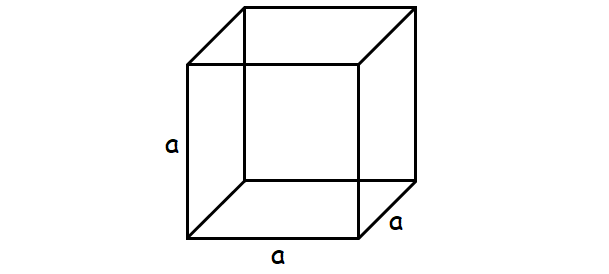
If the side of a cube is a units, then,
total surface area = 6a2 square units
lateral surface area = 4a2 square units
volume = a3 cubic units
Problem 1 :
Find the total surface area and lateral surface area of the cube whose side is
(i) 8 m (ii) 21 cm (iii) 7.5 cm
Solution :
(i) Side length is 8 m :
Total surface area = 6a2
= 6(8)2
= 6(64)
= 384 m2
Lateral surface area = 4a2
= 4(8)2
= 4(64)
= 256 m2
(ii) Side length is 21 cm :
Total surface area = 6a2
= 6(21)2
= 6(441)
= 2646 cm2
Lateral surface area = 4a2
= 4(21)2
= 4(441)
= 1764cm2
(iii) Side length is 7.5 cm :
Total surface area = 6a2
= 6(7.5)2
= 6(56.25)
= 337.5 cm2
Lateral surface area = 4a2
= 4(7.5)2
= 4(56.25)
= 225 cm2
Problem 2 :
If the total surface area of a cube is 2400 cm2 then, find its lateral surface area.
Solution :
Total surface area = 2400 cm2
6a2 = 2400
a2 = 2400/6
a2 = 400
a = 20 cm
Lateral surface area :
= 4a2
= 4(20)2
= 4(400)
= 1600 cm2
Problem 3 :
A cubical container of side 6.5 m is to be painted on the entire outer surface. Find the area to be painted and the total cost of painting it at the rate of $24 per m2.
Solution :
Side length of cubical container = 6.5 m
Total surface area of the container :
= 6a2
= 6(6.5)2
= 6(42.25)
= 253.5 m2
Total cost of painting at the rate of $24 per m2 :
= 253.5(24)
= $6084
Problem 4 :
Three identical cubes of side 4 cm are joined end to end. Find the total surface area and lateral surface area of the new resulting cuboid.
Solution :
Resulting cuboid :
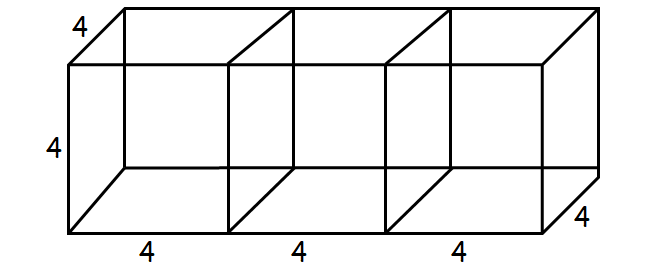
Length of resulting cuboid :
= 4 + 4 + 4
= 12 cm
Width = 4 cm and height = 4 cm
Total surface area of resulting cuboid :
= 2(lb + bh + hl)
= 2[12(4) + 4(4) + 4(12)]
= 2 [48 + 16 + 48]
= 2(112)
= 224 cm2
Lateral surface area of resulting cuboid :
= 2h(l + w)
= 2(4)(12 + 4)
= 2(4)(16)
= 128 cm2
Problem 5 :
A cubical tank can hold 64,000 liters of water. Find the length of its side in meters.
Solution :
Let ‘a’ be the side of cubical tank.
Volume = 64000 liters
1000 liters = 1 m3,
Volume = 64000/1000 m3
Volume = 64 m3
a3 = 64
a3 = 43
a = 4
Therefore, length of the side of the tank is 4 meters.
Problem 6 :
The side of a metallic cube is 12 cm. It is melted and formed into a cuboid whose length and width are 18 cm and 16 cm respectively. Find the height of the cuboid.
Solution :
volume of cuboid = volume of cube
l x w x h = a3
18 x 16 x h = 123
288h = 1728
Divide each side by 288.
h = 6 cm
Problem 7 :
One can of frosting covers about 280 square inches. Is one can of frosting enough to frost the cake? Explain.
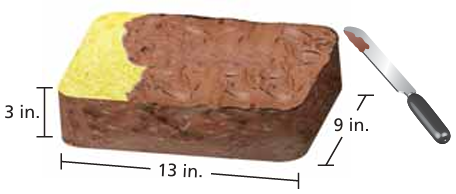
Solution :
Total surface area of covered by frosting
= 2(lw + wh + hl)
length = 13 inches, width = 9 inches and heigth = 3 inches
= 2(13 ⋅ 9 + 9 ⋅ 3 + 3 ⋅13)
= 2(117 + 27 + 39)
= 2(183)
= 366 square inches
So, one can of frosting cannot cover the cake.
Problem 8 :
Fifty percent of the surface area of the bread is crust. What is the height h?
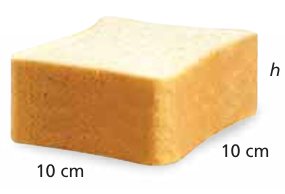
Solution :
length = 10 cm, width = 10 cm and height = h
Surface area of rectangular prism can be calculated in two different ways,
- Usign the formula 2(lw + wh + hl)
- Using the formula 2B + Ph
- Here B is the base area, h is height and P is perimeter of base.
Quantity of crust = 50% of surface area of bread
Crust of the bread will be out layer of the bread.
200 = 0.50[2(10⋅10) + 40h]
200 = 0.50[200 + 40h]
200/0.50 = 200 + 40h
400 = 200 + 40h
400 - 200 = 40h
40h = 200
h = 200/40
h = 5
So, the required height is 5 cm.
Problem 9 :
Compare the dimensions of the prism. How many times greater is the surface area of the red prism than the surface area of the blue prism?
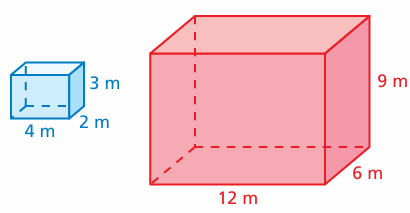
Solution :
Surface area of red prism = n(surface area of cube)
2(12(6) + 6(9) + 9(12)) = 2n[4(3) + 3(2) + 4(2)]
2[72 + 54 + 108] = 2n[12 + 6 + 8]
234 = n[26]
n = 234/26
n = 9
So, surface area of red prism is 9 times surface area of blue prism.
Problem 10 :
A keychain-sized puzzle cube is made up of small cubes. Each small cube has a surface area of 1.5 square inches.
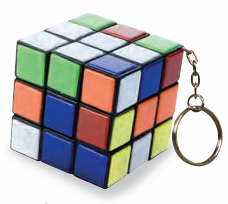
a. What is the side length of each small cube?
b. What is the surface area of the entire puzzle cube?
Solution :
a) Surface area of small cube = 6s2
Here s is the side length
6s2 = 1.5
s2 = 1.5/6
s2 = 0.25
s = 0.5
So, side lenght of the cube is 0.5 inch.
b) Number of small cubes in each side = 3
Side lenght of large cube = 3(0.5)
= 1.5
Surface area of entire puzzle = 6(1.5)2
= 6(2.25)
= 13.5 square inches.
Subscribe to our ▶️ YouTube channel 🔴 for the latest videos, updates, and tips.
Kindly mail your feedback to v4formath@gmail.com
We always appreciate your feedback.
©All rights reserved. onlinemath4all.com
Recent Articles
-
SAT Math Practice
Dec 05, 25 04:04 AM
SAT Math Practice - Different Topics - Concept - Formulas - Example problems with step by step explanation -
10 Hard SAT Math Questions (Part - 37)
Dec 03, 25 07:02 AM
10 Hard SAT Math Questions (Part - 37) -
Factorial Problems and Solutions
Dec 02, 25 09:27 AM
Factorial Problems and Solutions

